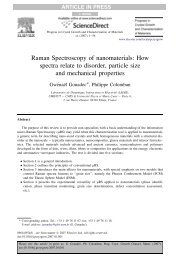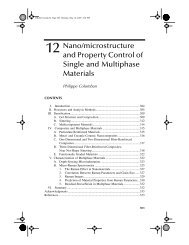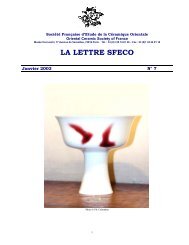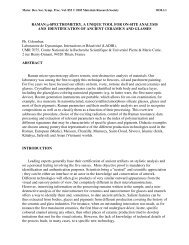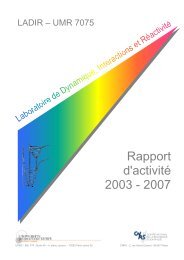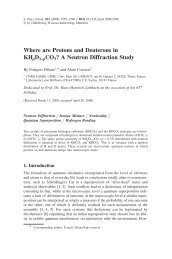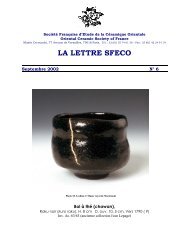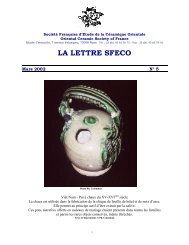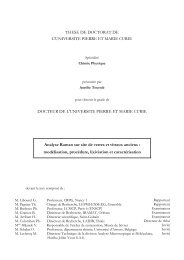Structure and dynamics of the symmetric hydrogen ... - ResearchGate
Structure and dynamics of the symmetric hydrogen ... - ResearchGate
Structure and dynamics of the symmetric hydrogen ... - ResearchGate
You also want an ePaper? Increase the reach of your titles
YUMPU automatically turns print PDFs into web optimized ePapers that Google loves.
400( )F. Fillaux et al.rChemical Physics 244 1999 387–403tively ‘broken’. The potential energy function in Fig.8 gives a ra<strong>the</strong>r modest dissociation energy <strong>of</strong> ;500y1Žy1cm 1.5 kcal mol .. This is a clear example <strong>of</strong> avery strong <strong>hydrogen</strong> bond that is none<strong>the</strong>less easilydissociated by <strong>the</strong>rmal activation <strong>and</strong> probably solventeffects.The dissociation energy can be regarded in twodifferent ways. In <strong>the</strong> most superficial view, this iscrudely <strong>the</strong> excess energy gain upon formation <strong>of</strong> <strong>the</strong>Žy1 y1<strong>hydrogen</strong> bond ;3000 cm or 9 kcal mol . afteraccounting for <strong>the</strong> strain energy, which is needed t<strong>of</strong>latten <strong>the</strong> ring. This illustrates how ambiguous <strong>the</strong>concept <strong>of</strong> binding energy can be for <strong>the</strong> case <strong>of</strong><strong>hydrogen</strong> bonds. For <strong>the</strong> <strong>hydrogen</strong> maleate ion, 1.5<strong>and</strong> 9 kcal mol y1 are equally acceptable values,depending on which initial <strong>and</strong> final states are considered.Moreover, <strong>the</strong>re is no straightforward reasonto consider that <strong>the</strong> bond energies should be correlatedto <strong>the</strong> strain energy. In this view, <strong>the</strong> dissociationenergy should be specific to a given system <strong>and</strong>quite different from any o<strong>the</strong>r <strong>symmetric</strong> <strong>hydrogen</strong>bond. This is largely in conflict with <strong>the</strong> well-establishedcorrelation between <strong>the</strong> OH stretching frequencies<strong>and</strong> <strong>the</strong> O PPP O distances in <strong>hydrogen</strong>bonded systems w31 x. Fur<strong>the</strong>rmore, energy gains uponformation <strong>of</strong> <strong>hydrogen</strong> or deuterium bonds should bedifferent <strong>and</strong> yield different dissociation energies.Instead <strong>of</strong> that, <strong>the</strong> very small frequency shifts obw21xshow that <strong>the</strong> dissociation energies are virtually iden-served in <strong>the</strong> infrared for <strong>the</strong> deuterium maleatetical for <strong>the</strong> two analogues.Alternatively, in a broader view, <strong>the</strong> dissociationenergy can be seen a consequence <strong>of</strong> <strong>the</strong> quantumnature <strong>of</strong> <strong>the</strong> <strong>hydrogen</strong> bond because <strong>the</strong> totally<strong>symmetric</strong> structure Ž. I only exists in <strong>the</strong> vibrationalground state. The probability distribution for <strong>the</strong>2proton C is well localized at <strong>the</strong> center Ž Fig. 8 .0.The probability distributions <strong>of</strong> vibrational excitedstates, Cn2 , show that <strong>the</strong> proton is largely localizedaway from <strong>the</strong> central position. Then, structure Ž II.is <strong>the</strong> dominant one <strong>and</strong> <strong>the</strong> <strong>hydrogen</strong> bond is broken.In o<strong>the</strong>r words, <strong>the</strong> proton ground state is‘<strong>hydrogen</strong> bonding’ whilst excited states are ‘<strong>hydrogen</strong>anti-bonding’. If this mechanism is correct, <strong>the</strong>vibrational spectra are not simply related to <strong>the</strong>energy gain upon <strong>the</strong> <strong>hydrogen</strong> bond formation <strong>and</strong>systems containing formally <strong>symmetric</strong> <strong>hydrogen</strong>bonds should have similar dissociation thresholds,<strong>and</strong> overall potential functions, almost independently<strong>of</strong> <strong>the</strong>ir chemical nature. The correlation betweenfrequencies <strong>and</strong> distances is thus recovered, as wellas <strong>the</strong> very small frequency shifts upon deuteration.It might be argued that proton <strong>dynamics</strong> in intermolecularsystems with short <strong>symmetric</strong> <strong>hydrogen</strong>bonds have been interpreted differently w38,39 x.However, we suspect <strong>the</strong>y are amenable to potentialfunctions similar to that for potassium <strong>hydrogen</strong>maleate.7.3. Infrared spectraInfrared spectra reported for an electrical fieldparallel to <strong>the</strong> <strong>hydrogen</strong> bond Ž E in Ref. w21x.5 c<strong>and</strong><strong>the</strong> potential presented in Fig. 8 can be rationalisedon <strong>the</strong> basis <strong>of</strong> symmetry related selection rulesŽ Table 6 .. For a <strong>symmetric</strong>al <strong>hydrogen</strong> bond, infraredintensities are determined by <strong>the</strong> leading terms<strong>of</strong> <strong>the</strong> dipole moment derivatives E 2 j MrEr 52 j . Consequently,transitions from <strong>the</strong> ground state to anti<strong>symmetric</strong>states are inactive. The ra<strong>the</strong>r broad b<strong>and</strong>sobserved at 545, 700 <strong>and</strong> 990 cm y1 may thus corre-Žy1. Žy1spond to <strong>the</strong> 02 530 cm , 04 744 cm .Žy1<strong>and</strong> 06 958 cm . transitions. Conversely, transmissionwindows reported at 605 <strong>and</strong> 795 cm y1 areŽy1attributed to <strong>the</strong> 03 665 cm . <strong>and</strong> 05 Ž856y1cm . inactive transitions. The additional transmissionwindow visible at ;1050 cm y1 in <strong>the</strong> infraredspectrum ŽFig. 2 in Ref. w21x.may correspond to <strong>the</strong>y107 transition calculated at 1065 cm Ž Table 6 ..This assignment scheme suggests that <strong>the</strong> <strong>hydrogen</strong>bond is effectively <strong>symmetric</strong>al even on <strong>the</strong> shortŽy13time-scale <strong>of</strong> vibrational spectroscopy ;10 –y1410 s .. The alternative assignment scheme prow21x, based on a very broad n aposed previouslyOHO b<strong>and</strong> with transmission windows due to stronganharmonic coupling with o<strong>the</strong>r internal vibrations,is clearly in disagreement with <strong>the</strong> INS spectra.7.4. B<strong>and</strong> shapesThe ra<strong>the</strong>r sharp b<strong>and</strong>s observed for <strong>the</strong> protonstretching-mode suggest well-defined excited stateswith ra<strong>the</strong>r long lifetimes. There is no evidence for<strong>the</strong> relaxation <strong>of</strong> <strong>the</strong> maleate ring to <strong>the</strong> twist configurationby rotation <strong>of</strong> a carboxylic group in <strong>the</strong>proton excited states. Therefore, excited states corre-



